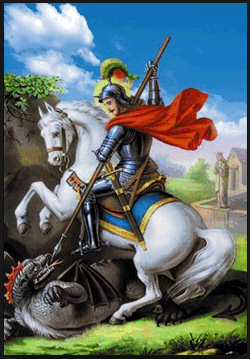
The legend of Saint George is a fascinating one, and reflects the victory of good over evil, as it should in our lives on a daily basis. Historical records of early Christendom, saints and martyrs during the early days of Christianity are very rare and difficult to come across. Saint George was one such Christian martyr about who very little is preserved in history. The traditional account of his life is considered to have originated in the 4th century. According towhich, George was born to a Christian family during the late 3rd century. His father was from Cappadocia and served as an officer of the army. His mother was from Lydda, Palestine. She returned to her native city as a widow along with her young son. She is said to have provided her son with a respectable education.
The youth followed the example of his father in joining the army soon after his coming of age. He proved to be a charismatic soldier and consequently rose quickly through the military ranks of the time. By his late twenties he had gained the titles of tribunus (tribune) and comes (count). By that time, George had been positioned in Nicomedia as a member of the personal guard attached to Roman Emperor Diocletian (reign AD 284 - 305). In AD303, Emperor Diocletian issued an edict authorizing the systematic persecution of Christians across the Empire. His heir Caesar Galerius was responsible for this decision and the persecution continued during his own reign (AD 305 - 311). George was ordered to take part in the persecution and criticized the imperial decision. An enraged Diocletian proceeded in ordering the torture of this apparent traitor and his execution. After various other tortures, George was reportedly executed by decapitation in front of Nicomedia’s defensive wall on April 23, 303 AD. The witness of his suffering convinced Empress Alexandra and an unnamed pagan
priest to also become Christians; they also joined George in martyrdom. His body was then returned to Lydda for burial. Christians soon came to honor George as a martyr.
The most famous legend associated with Saint George is that of St. George and the Dragon. According to the legend, a terrible dragon had ravaged all the country round a city of Libya, called Selena, making its lair in a marshy swamp. Its breath caused pestilence whenever it approached the town, so the people gave the monster two sheep every day to satisfy its hunger, but, when the sheep failed, a human victim was necessary and lots were drawn to determine the victim. On one occasion the lot fell to the king’s little daughter. The king offered all his wealth to purchase a substitute, but the people had pledged themselvesthat no substitutes should be allowed, and so the maiden, dressed as a bride, was led to the marsh. There St. George chanced to ride by, and asked the maiden what she did, but she bade him leave her lest he also might perish. The good knight stayed, however, and, when the dragon appeared, St. George, making the sign of the cross, bravely attacked it and transfixed it with his lance. Then asking the maiden for her girdle (an incident in the story which may possibly have something to do with St. George’s selection as patron of the Order of the Garter), he bound it round the neck of the monster, and thereupon the princess was able to lead it like a lamb. They then returned to the city, where St. George bade the people have no fear but only be baptized, after which he cut off the dragon’s head. This convinced the villagers to accept Christianity. The king would have given George half his kingdom, but the saint replied that he must ride on, bidding the king meanwhile to take good care of God’s churches, honour the clergy, and have pity on the poor.
Due to his chivalrous behaviour (protecting women, fighting evil, dependence on faith and might of arms, largesse to the poor), devotion to Saint George became popular in the Europe after the 10th century. In the 15th century his feast day was as popular and important as Christmas. Many of his areas of patronage have to do with life as a knight on horseback. The celebrated Knights of the Garter are actually Knights of the Order of Saint George. The
Shrine built for his relics at Lydda, Palestine was a popular point of pilgrimage for centuries.
Historically, Saint George has represented the victory patron saint of the Christian armies fighting the Muslims for control of the holy land during the crusades. King Edward III of England (reigned 1327-1377) was known for promoting the codes of knighthood and in 1348 founded the Order of the Garter.
He is also the patron saint of Moscow, Georgia, and England, amongst other places. In 1969, the feast of Saint George was dropped from the Roman Catholic calendar, and his commemoration reduced to a purely local observance. He is however still honoured as a saint of major importance by Eastern Orthodoxy. The examples set by Saint George to being model Christian, soldier, protector and benefactor of the poor and the tormented are very relevant in our lives today. His legacy should be remembered and honoured by all of us. The Orthodox Church has a special affinity to Saint George and continues to honour his name and memory by dedicating churches in his name and celebrating his feast day on April 23and the translation of his relics on November 3.